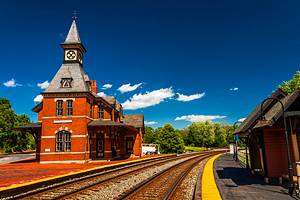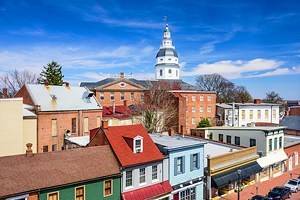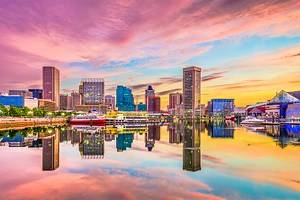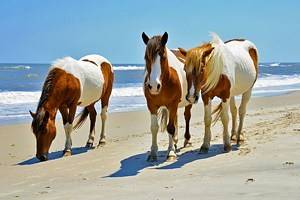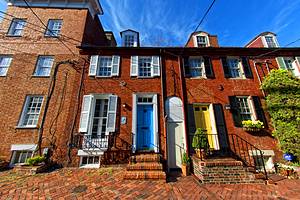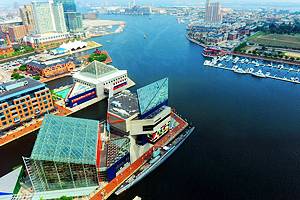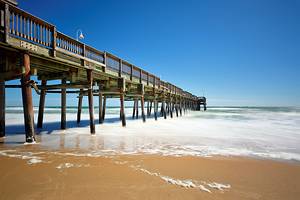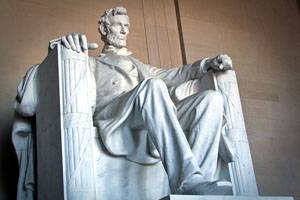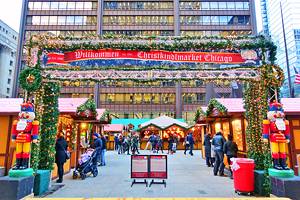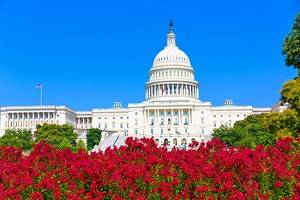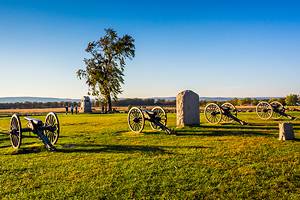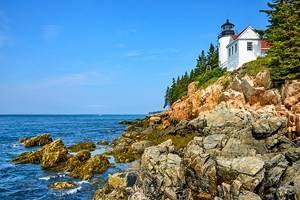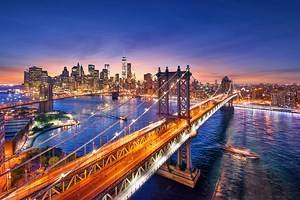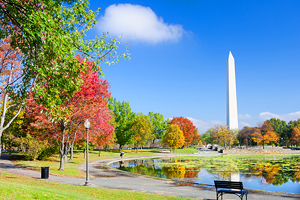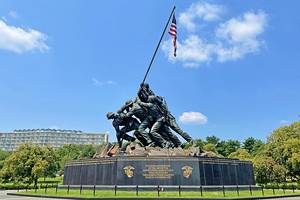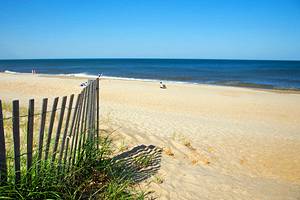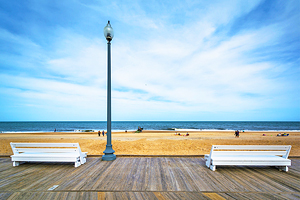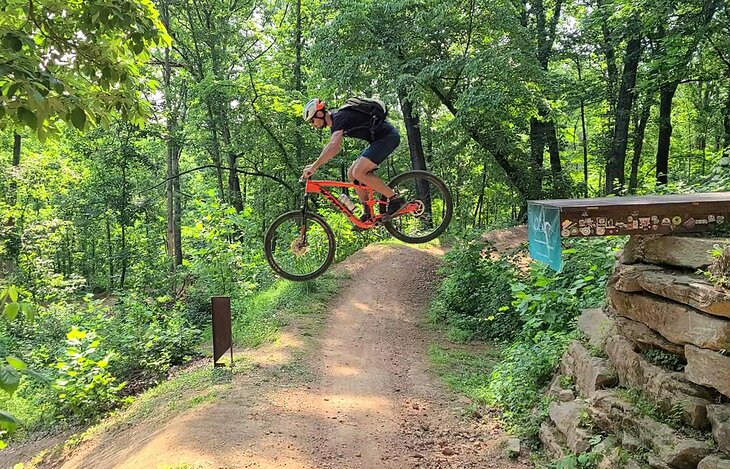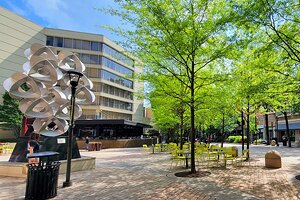20 Top-Rated Tourist Attractions in Maryland
The small state of Maryland wraps around the huge Chesapeake Bay, which almost divides it in half. The state is almost divided again, farther west, where at one point only 1.6 miles of Maryland separates the West Virginia and Pennsylvania state lines.
Also bordered by Delaware, Virginia, and the District of Columbia, Maryland lies at the heart of Colonial America and saw action in the Revolution, War of 1812, and Civil War. Its place in the forefront of American history also includes important roles in the Underground Railroad, the Industrial Revolution, the westward expansion, the Space Age, and every other major period in America's story.
For a state its size, Maryland also offers tourists a wide variety of natural attractions, from the long beaches of its Eastern Shore to the heavily forested hills of its western counties. The Appalachian Mountains cross in the west, and state parks protect waterfalls, lakes, and plenty of walking and hiking trails.
The former towpath of the C&O Canal offers miles of cycling, and wildlife refuges protect precious wetlands for waterfowl and migrating birds.
Whether your interests are history, hiking, birding, sightseeing, or soaking up the sun on a beach, you'll find plenty of things to do in Maryland. To find the best places to visit, follow this list of the top tourist attractions in Maryland.
- Fort McHenry National Monument
- National Aquarium
- The Walters Art Museum
- Baltimore Museum of Art
- Baltimore Inner Harbor
- Old Town Annapolis and William Paca House
- Assateague State Park
- American Visionary Art Museum
- Ocean City Boardwalk
- Antietam National Battlefield
- U.S. Naval Academy Museum and Chapel
- B & O Railroad Museum
- Oriole Park at Camden Yards
- Chesapeake Bay Maritime Museum
- Chesapeake & Ohio Canal National Historical Park
- Fell's Point
- Swallow Falls State Park
- Harriet Tubman Underground Railroad National Historical Park
- Deep Creek Lake
- Blackwater National Wildlife Refuge
Fort McHenry National Monument

Completed in 1803 to guard the entrance to Baltimore's busy harbor, Fort McHenry became a national icon after withstanding a 24-hour bombardment by the British in 1814. The fort saved Baltimore from occupation and inspired Francis Scott Key, who was being held prisoner on a British ship during the attack, to write The Star Spangled Banner.
You can walk the ramparts, tour the buildings, and watch a dramatic multimedia presentation on the history of the fort and the national anthem.
Fort McHenry is the highlight of the 560-mile Star-Spangled Banner National Historic Trail, which traces the Chesapeake Campaign of the War of 1812 through Virginia, Washington, D.C., and central Maryland. Other sites along the trail are the Star-Spangled Banner Flag House in Baltimore and Sotterley Plantation, site of a British raid during the war. You can download a map to find other sites.
Address: Fort Ave, Baltimore, Maryland
- Read More: Top-Rated Tourist Attractions in Baltimore
National Aquarium
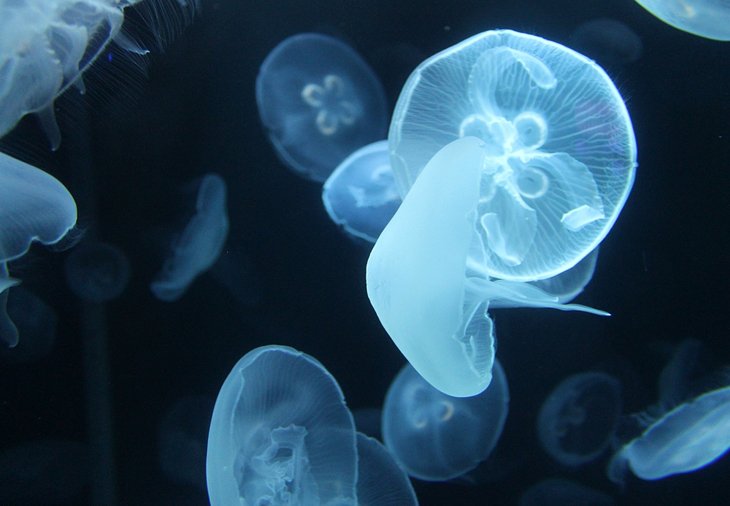
The dramatic National Aquarium building overlooking Baltimore's Inner Harbor replicates several ecosystems as homes for marine life from all over the world, as well as birds, mammals, and appropriate plant life.
At the Atlantic Coral Reef Exhibit, you can descend through a 335,000-gallon exhibit where you are surrounded by a rainbow of nearly 100 species of colorful tropical fishes and other reef species, including blacknose sharks. An especially popular thing to see is feeding time, when divers feed the reef fish.
Not all the environments are underwater, but they share a common connection to water. The largest of these is the five-story Amazon River Forest, which you can explore at various levels from the forest floor to the treetops to see birds, frogs, plants, and even sloths and monkeys.
One of the most popular things to do at the aquarium is watching the six Atlantic bottlenose dolphins from an underwater viewing area. Dolphin Discovery is the Aquarium's largest exhibit, and you can also watch these fascinating creatures play and interact with each other from the amphitheater.
Author's Tip: Every Friday evening from 5 to 8pm year-round, museum entrance is half-price; you can get advance tickets online or buy them at the entrance.
Address: Pier 3 and 4, Inner Harbor, Baltimore, Maryland
The Walters Art Museum
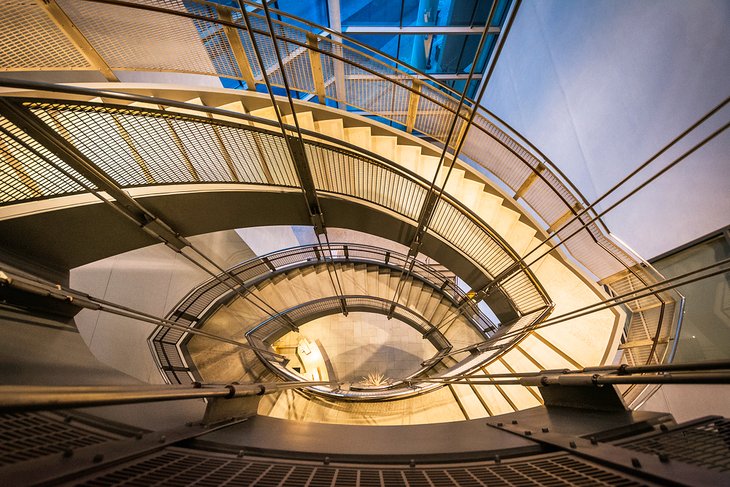
In Baltimore's Mount Vernon Cultural District, the Walters Art Museum is a unique cultural landmark and one of only a handful of institutions in the world that presents such a comprehensive history of world art.
Covering all media of art from the third millennium B.C. through the early 20th century, the collections - all beautifully displayed and interpreted - are best known for their exceptional jewelry, enamels, ivories, bronzes, and illuminated manuscripts.
Egyptian, Greek, Roman, and Byzantine antiquities are outstanding, as is the medieval and Renaissance art collections. The museum has especially good interpretive materials to engage young people in exploring its collections.
Tip for Parents: Stop on the way in to pick up booklets with puzzles, treasure hunts and activities that engage children in the exhibits. Before and after a visit you can explore Art Adventures, the museum's free virtual programs that include art-making videos and downloadable activity packets.
Address: 600 North Charles Street, Baltimore, Maryland
Baltimore Museum of Art
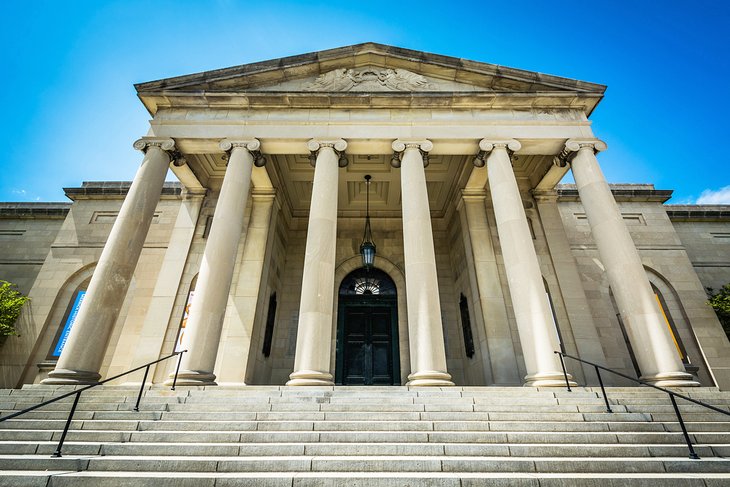
Known for its superb collections of 19th-century, modern, and contemporary art, the Baltimore Museum of Art now holds 95,000 works by artists that include Pablo Picasso, Paul Cezanne, Vincent van Gogh, Andy Warhol, Joan Miró, and Marc Chagall, in addition to the world's largest collection of works by Henri Matisse.
Along with paintings, sculpture, and graphic arts, the BMA displays notable collections of textiles, jewelry, and furniture, as well as African, Asian, and Near Eastern art. The African collections are among the most important in the United States, comprising more than 2,000 objects ranging from ancient Egyptian art to contemporary works. Masks, headdresses, figural carvings, jewelry, royal staffs, textiles, ceremonial items, and pottery reflect more than 200 African cultures.
Outside the museum, two landscaped Sculpture Gardens present a century of modern and contemporary sculptures. Inside the building, the highly acclaimed restaurant, Gertrudes, features the bounty of the Chesapeake Bay and its surrounding farmlands.
Tip for Parents: Free Family Sundays include monthly drop-in art workshops in the Fox Court from 2 to 5pm. These usually explore themes suggested by current museum exhibits and are designed for families with children ages 6 through 9; all materials are provided.
Address: 10 Art Museum Drive, Baltimore, Maryland
Read More: Best Weekend Getaways in Maryland
Baltimore Inner Harbor
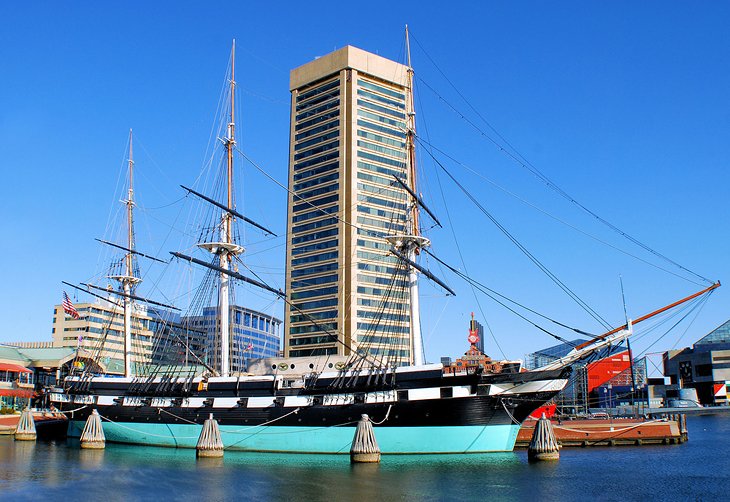
Baltimore's Inner Harbor is a magnet for visitors, filled with attractions and entertainment options. The whole area and the neighborhoods just back from the water have been nicely developed with parks, hotels, restaurants, shops, museums, and historic ships to tour.
Foremost of these is the sloop-of-war USS Constellation, a three-masted sailing ship that saw action in the Civil War and intercepting slave ships off the African coast. Also open to tour are the submarine USS Torsk, the US Coast Guard Cutter Taney, and the Lightship Chesapeake.
Surrounding the harbor are the National Aquarium, the Visionary Art Museum, and the interactive Maryland Science Center. Along with a planetarium, the science center is filled with hands-on experiments, demonstrations, and science activities, making it one of Baltimore's favorite places to go for families.
Harborplace is a modern complex anchored by glass-enclosed pavilions featuring shops, restaurants, and an amphitheater on the promenade.
Old Town Annapolis and William Paca House
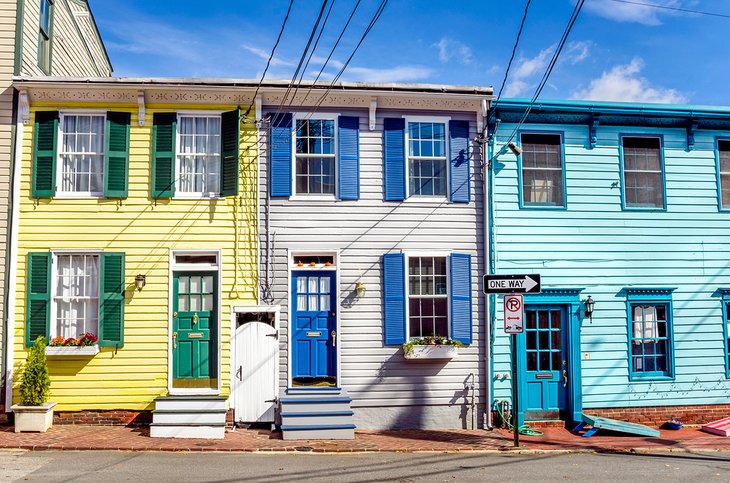
The few blocks of Old Town Annapolis between the Town Dock and the Maryland State House are filled with equal measures of history and charm. Once the United States Capitol, the State House is the oldest one still in continuous legislative use.
A short way down the hill, through narrow streets lined with picture-worthy brick and clapboard buildings, is the William Paca House and Garden, home of the signer of the Declaration of Independence, William Paca. Fully restored and furnished in period antiques and original Paca family items, the house is an outstanding example of the home of an influential and prosperous Annapolis family of the Colonial era and is on the National Register of Historic Places.
The two-acre garden, with terraces, topiary, and a fish-shaped pond, has also been restored to its 1760s appearance.
Author's Tip: On hot summer days, take a break from historic sites and head to Sandy Point State Park, on the shore of Chesapeake Bay. Lifeguards are on duty at the mile-long sandy beach, and you can rent boats at the park's marina to get views of Annapolis from the water. In December the beach turns into a colorful holiday wonderland as Lights on the Bay fills the park with more than 70 illuminated displays, many of them animated.
Address: 186 Prince George Street, Annapolis, Maryland
Assateague State Park
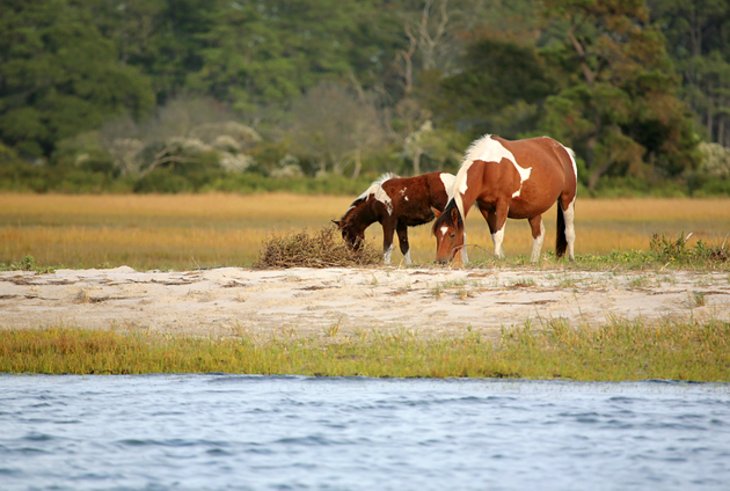
Assateague State Park is on Assateague Island, a barrier island on Maryland's Eastern Shore. On the east side of the island is the windswept landscape of the Atlantic Ocean, with a long stretch of beach that's popular in the summer for swimming and surfing.
On the more protected bayside of the island, park visitors enjoy fishing and kayaking. The island supports a range of wildlife but is known in particular for the feral horses that roam the dunes and windswept grassland. The park has campsites, picnic tables, a camp store, and a snack bar. The closest town is Berlin, about eight miles away.
American Visionary Art Museum
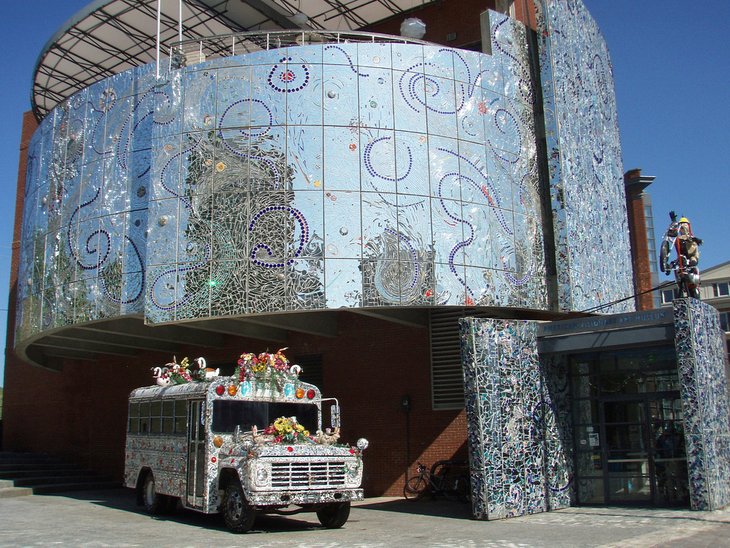
A standout, even in Baltimore's rich art environment, the American Visionary Art Museum displays and celebrates the work of self-taught artists, both local and from around the world. Its collection and frequently changing exhibits are often surprising and thought-provoking, looking at art in new ways and from new perspectives.
These may represent traditional folk arts that have been passed down through generations, or they may be creative uses of found materials by artists using whatever medium was available to satisfy their creative drive. The exhibits that fill its main building - itself an award-winning work of art - and the adjoining sculpture barn will never be boring and will likely leave you smiling.
Sculpture is a prominent feature here, and each May an array of original sculptures take to the streets of Baltimore in the museum's Kinetic Sculpture Race. Outlandish human-propelled "vehicles" complete a 15-mile circuit through the city that includes climbing hills and other obstacles.
Crowds line the course, and the most popular viewing spot is where the vehicles go down a ramp and into the harbor, and where the unseaworthy sink. Food trucks line the way to feed spectators, who join in the fun by dressing in crazy costumes. Only in Baltimore.
Address: 800 Key Highway, Baltimore, Maryland
Ocean City Boardwalk
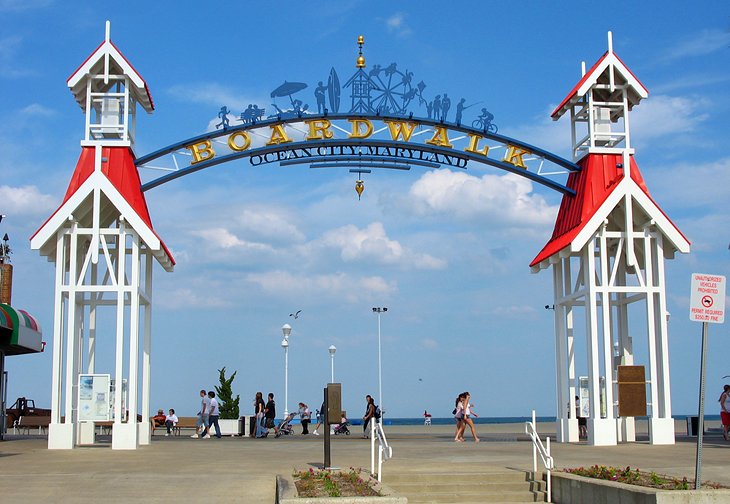
Among the most popular beaches in Maryland and of the mid-Atlantic coast, Ocean City has 10 miles of free public beach and a three-mile classic wooden boardwalk that has been acclaimed as the nation's best. Along this popular promenade are shops, a Ferris wheel, a roller coaster, a 1902 carousel, and kiosks selling foods that range from the famous Delmarva fried chicken to saltwater taffy and hot funnel cakes.
A tram carries visitors between attractions, and on the beach are frequent free concerts, movies, and other evening activities. The Ocean City Life-Saving Station Museum has a saltwater tank where you can see local sea creatures.
With miles of uninterrupted ocean shoreline and acres of creeks and back bays to explore, Ocean City is a prime spot for water sports. Consistent year-round waves attract surfers, and several surf schools can teach you how to catch them. A half-dozen surf shops are ready with gear.
You can also rent stand-up paddleboards, or you can explore some of the wildlife-rich creeks in a kayak or canoe. Family-owned Ayers Creek Adventures can take you on guided eco-tours of the tidal creeks and back bays.
Antietam National Battlefield

Few places illustrate the terrible cost of war like Antietam National Battlefield, the scene of the bloodiest day's battle in the Civil War. On September 17, 1862, the Union army, coming from the east, met Robert E. Lee's Confederates, approaching from the west. In the battle that followed, nearly 23,000 men were killed, wounded, or missing in action.
Today, the battlefield is still open countryside, studded with monuments to the regiments of both sides. Civil War buffs will want to follow the entire eight-mile, self-guided tour route (on foot, on a bicycle, or by car); others should at least not miss the old Dunker Church, where the first clash occurred; the Sunken Road, where the next phase played out; and Burnside Bridge, where Union troops at great cost finally forced General Lee to withdraw.
Tip to Parents: Older children will get more out of touring the battlefield by downloading the treasure hunt from the National Park website. Questions on the treasure hunt encourage them to read the signs as you follow the auto tour.
U.S. Naval Academy Museum and Chapel
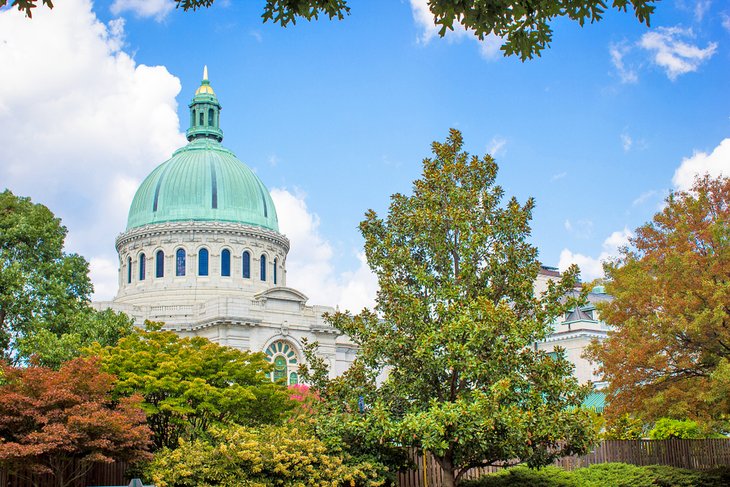
The U.S. Naval Academy Museum preserves artifacts and memorabilia relating not only to the academy but to important figures and engagements in America's naval history.
Along with medals, uniforms, and personal items are artifacts from historically significant events. These include the table on which the surrender was signed that ended World War II, along with the flag that flew at the signing on the deck of the USS Missouri.
An entire room is dedicated to ship models, remarkable for the fact that each model was made at the same time that the ship itself was being constructed. Some date as early as the mid-1600s, and several are the only records remaining of the ship's construction and features. The collection of ships' instruments is equally impressive, as are smaller exhibits, such as the painstakingly crafted examples of art created by prisoners on board naval ships. The museum is free.
The chapel, which was an important feature leading to the Academy's designation as a National Historic Landmark, is notable for its striking stained-glass windows filled with symbolism of the high ideals of the service and others commemorating naval heroes. In the crypt, is the elaborate tomb of naval hero John Paul Jones.
A visit to the Academy should begin at the Armel-Leftwich Visitor Center, where you can join a guided tour or watch the 13-minute film, The Call to Serve.
Address: 118 Maryland Avenue, Annapolis, Maryland
B & O Railroad Museum
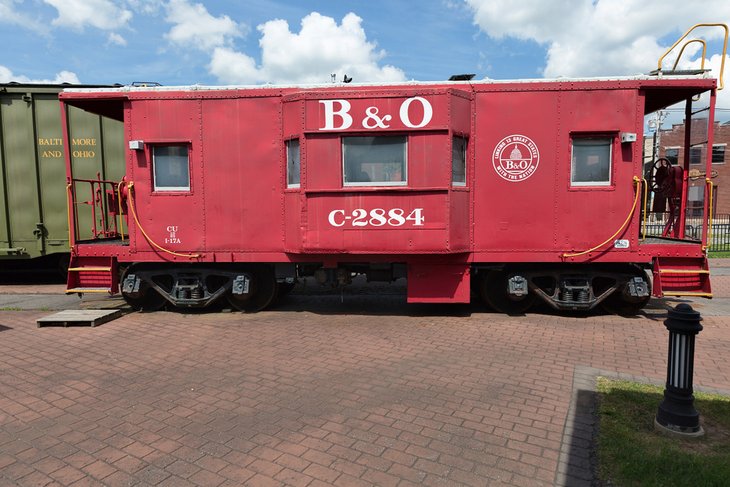
The B & O Railroad Museum is one of Baltimore's most popular places to see and offers a look at some of America's railroad history. The museum operates out of historical buildings, including the Mount Clare Station, and showcases an extensive collection of locomotives and coaches, most of them in working order.
The main attraction in the Roundhouse, where the rolling stock is displayed, is a turntable with 22 connecting lines. The Mont Clare Station is itself an important part of American rail history, as it was from here that the first passenger train in the United States traveled to Ellicott's Mills in 1830.
The interactive exhibit, The Underground Railroad: Freedom Seekers on the B&O Railroad, highlights the role that B&O trains played in helping enslaved people to escape to freedom. It tells the stories of 27 people who made their way north to safety via the actual railroad with the assistance of "conductors" who hid and fed them.
The exhibition is located in the museum's Mt. Clare Station, through which some of the Freedom Seekers traveled in their escape.
Address: 901 West Pratt Street, Baltimore, Maryland
Oriole Park at Camden Yards
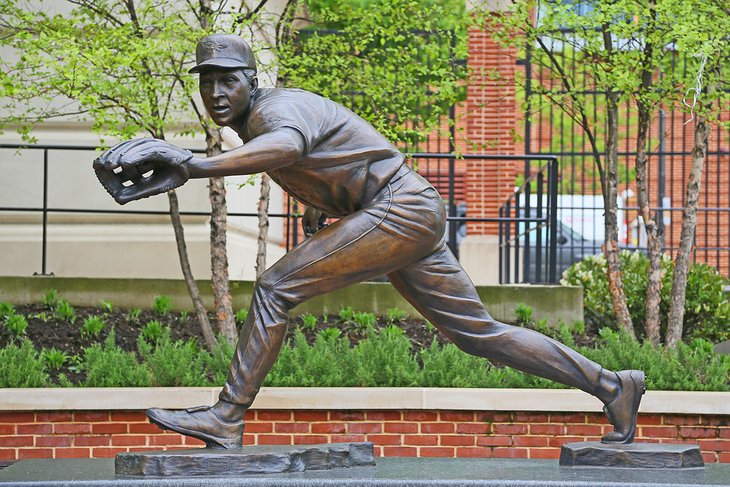
Home of the Baltimore Orioles, the city's Major League baseball team, Oriole Park at Camden Yards opened in 1992 and heralded a new era in ballpark construction. Eschewing the characterless multi-purpose suburban stadiums, Oriole Park recalls the classic in-town feel of old-fashioned ballparks like Boston's Fenway Park, but with all the latest state-of-the-art facilities.
Located in the former rail center of Camden Yards, it is within sight of the Inner Harbor in the heart of downtown Baltimore. Fittingly, it is only two blocks from the birthplace of baseball's most legendary hero, George Herman "Babe" Ruth. Ruth's father operated Ruth's Cafe on the ground floor of the family's home, a spot that is now in center field at Oriole Park.
The modest home in which Babe Ruth was born is now a museum, and a statue of Babe Ruth stands just outside the park. You can tour Oriole Park for a look behind the scenes in the press box, club levels, and dugout.
Chesapeake Bay Maritime Museum

The 1879 Hooper Strait Lighthouse, at the Chesapeake Bay Maritime Museum, is the visual centerpiece of a collection of historic buildings and boats that illustrate life and work on the Chesapeake Bay since the Native Americans hollowed out logs for canoes.
In the Small Boat Shed, you can see working and recreational watercraft used throughout the bay's history, including early settlers' adaptations of Native American canoes to use for fishing and oystering.
At Waterman's Wharf, hands-on and audio exhibits draw visitors into the world of oystermen and crabbers in a typical shanty and onboard an oystering skipjack. You can also visit the former home of Eliza Bailey Mitchell, sister of abolitionist Frederick Douglass, and an Heirloom Garden of kitchen and medicinal plants cultivated along the bay since Native American times. A working boatyard continues boat-building and repair traditions as staff maintains the museum's Floating Fleet.
The Chesapeake Bay hosts one of the world's great bird migrations as hundreds of thousands of water, shore, and songbirds shelter in its shoreline marshes each spring and fall. Along with hunting and birding, this migration has given rise to an entire genre of waterfowl art. You can see exhibits here on the waterfowl, while each November in nearby Easton, the Easton Waterfowl Festival is the country's premier wildlife art show.
Address: 213 North Talbot Street, St. Michaels, Maryland
Chesapeake & Ohio Canal National Historical Park
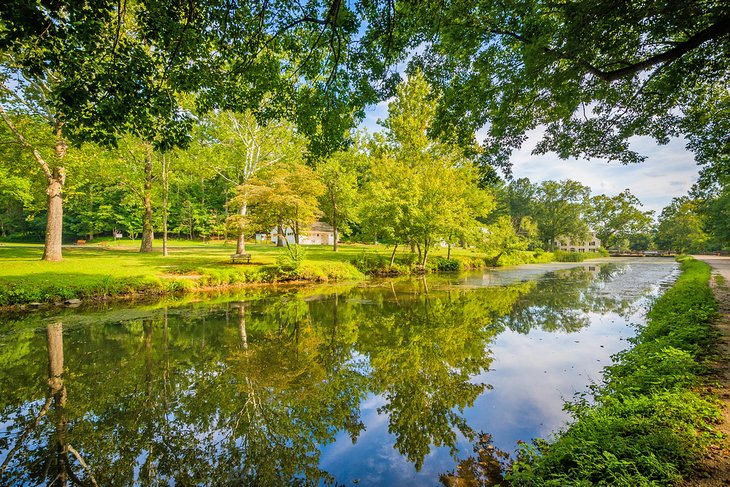
The C&O Canal operated from 1828-1924 as a transportation route, primarily hauling coal along the Potomac River to Georgetown. Hundreds of locks, lock houses, and aqueducts are still standing as reminders of the canal's role as a transportation system during the Canal Era. The canal follows the route of the Potomac River from Washington, D.C. to Cumberland, MD.
Bordering the canal are the well-maintained towpaths, where mules and horses once labored to pull barges through the canal. The route is now a park, and the towpath is a favorite for walking and cycling, and in certain parts, for horseback riding. In most places, the route is shaded by trees, which give way frequently to reveal views of the Potomac River.
All along the route are locks, lock-keepers' cottages, and the remains of canal buildings. Perhaps the most interesting of these examples of canal architecture is the Monocacy Aqueduct, a seven-arched stone bridge that carried the canal across the Monocacy River. Built between 1828 and 1833, the 536-foot-long aqueduct is an icon of the canal and of transportation history.
Several sections of the C&O Canal have been re-watered, and you can kayak in these and along the Potomac River adjacent to the National Park. You can rent kayaks, rowboats, canoes, paddle boards, and bikes at Fletcher's Boathouse at Mile Marker 3.2 on the Washington, DC, end of the canal.
Toward the western end, at Mile Marker 99.6, the canal is re-watered from Cushwa Basin to just below Lockhouse 44, and is a favorite place to go fishing.
Fell's Point
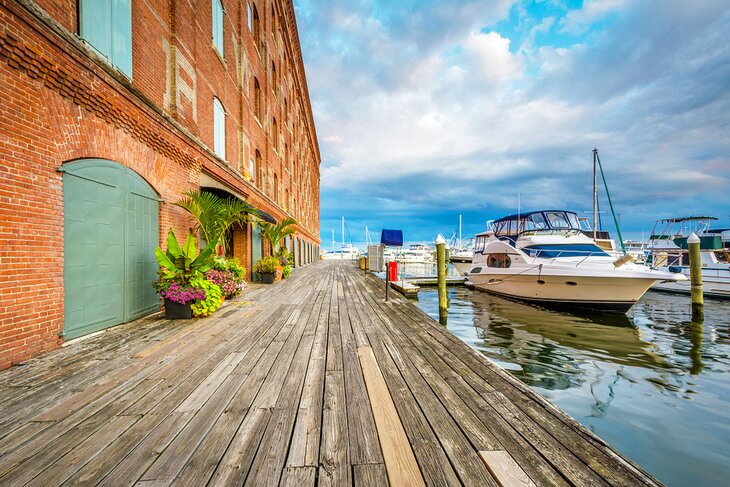
The historic neighborhood of Fells Point was once Baltimore's shipbuilding center and is now one of its liveliest meeting places. More than 100 small businesses, including restaurants, cafes, and locally owned shops, line Main Street and fill the restored brick buildings of its adjoining lanes and waterfront. More than 300 of these are historic National Register buildings.
The first shipyard owned by an African American is now home to the Frederick Douglass-Isaac Myers Maritime Park Museum, celebrating the contributions of African Americans in the development of Baltimore's maritime industry. In one of the city's oldest waterfront industrial buildings, the museum memorializes abolitionist Frederick Douglass and Isaac Myers, a free-born African American who established the Chesapeake Marine Railway and Dry Dock Company and was a prime mover in unionizing African American workers.
Be sure to stop in the lively market building, where vendors sell local foods. In early October, during the Fell's Point Fun Festival, the entire six-block harbor area becomes a giant market of foods and works by local artists and artisans.
Swallow Falls State Park
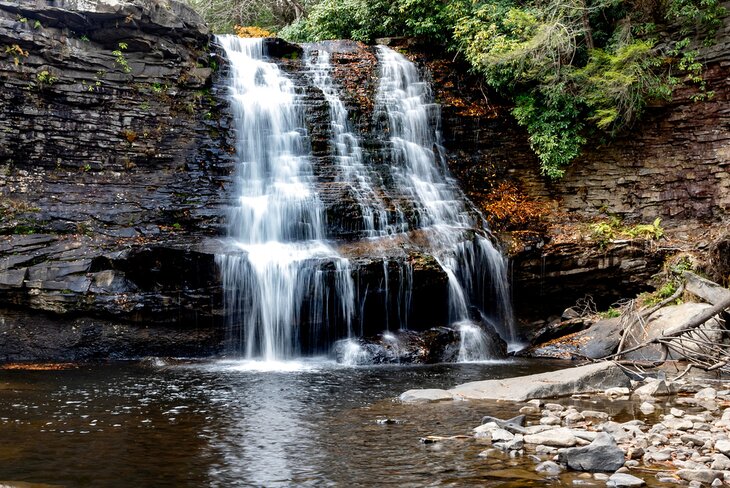
Near Oakland, in western Maryland, Swallow Falls State Park lies at one side of the Youghiogheny River (pronounced Yawk-a-gainy, and popularly known as "The Yough") and hides a world of rushing rapids, cascades, cliffs, rock formations, gorges and a 53-foot waterfall.
You can see all this from a moderately easy trail about 1¼ miles long, passing through beautiful woods before opening onto a stream and Muddy Creek Falls, the tallest waterfall in Maryland. Follow the trail along the stream and through a canyon until it reaches the Youghiogheny River. The trail continues upstream and through a steep-sided canyon.
The rock faces extend over the trail in cave-like formations before you reach Lower Swallow Falls and then Upper Swallow Falls. Look for Swallow Rock, a stone pillar left as the river wore through softer surrounding rock. The falls are named for the cliff swallows that once nested among the rocks.
The fast-moving waters of the Youghiogheny are good for fly fishing, upstream from Swallow Falls to Sang Run. But The Yock's real fame is with whitewater kayakers, who brave the class IV and V rapids of the legendary Upper Yough, in Pennsylvania.
Address: 2470 Maple Glade Road, Oakland, MD
Harriet Tubman Underground Railroad National Historical Park
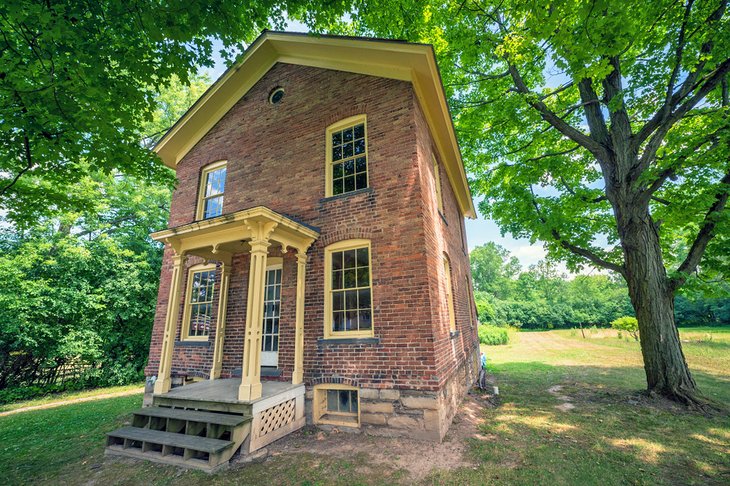
Established in 2022, in recognition of the 200th anniversary of her birth, the Harriett Tubman Underground Railroad National Historical Park is a combination state and national park on Maryland's eastern shore. The park brings together several places significant in the life of this formerly enslaved woman who devoted her life to helping others escape.
She was the best-known "conductor" in the Underground Railroad, a secret network of volunteers who hid and fed those escaping slavery and saw them on their way to the next "station" until they reached Canada and freedom. She is known to have risked her life repeatedly to guide at least 70 enslaved people north to new lives.
At the Harriet Tubman Underground Railroad Visitor Center, you'll find exhibits, an audio-visual program, and interpretive programs on Tubman and her work. Visit sites surrounding Harriet Tubman's home, where she was born into slavery, escaped, and returned to guide her family and friends north to freedom.
Tip to Parents: At the National Historical Park, your kids can begin their collection of National Park Trading Cards by attending a ranger program or engaging with rangers by asking questions or joining discussions. Cards here relate to the Underground Railroad and the Civil Rights Movement. Kids can expand their collections as they visit other parks in Maryland, including Antietam National Battlefield, the C&O Canal, Fort McHenry, and Monocacy National Battlefield.
At the Harriet Tubman Museum & Educational Center in Cambridge, you can learn more about her life, and see the powerful mural completed in 2019.
These and other sites are part of a self-guided road trip, the Tubman Byway, which you can follow with a free map or free audio guide. The surrounding landscapes and waterways look much as they did when she lived here, much of it protected by the adjacent Blackwater National Wildlife Refuge.
Address: 4068 Golden Hill Road, Church Creek, Maryland
Deep Creek Lake
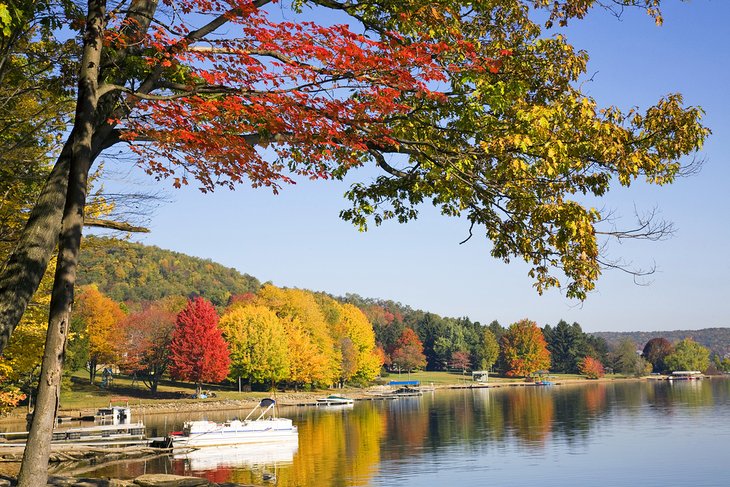
Maryland's western mountain region is a playground that's often overlooked as tourists head for the eastern beaches. But Deep Creek Lake has 69 miles of shoreline to explore and nearly 4,000 acres of water in which to sail, paddle, fish, or swim.
Along its shores are resorts; beaches; spas; shops; waterside restaurants; and places to rent canoes, sailboats, kayaks, and bicycles.
The mile of shoreline with two beaches is part of Deep Creek State Park, where you'll also find a campground; 20 miles of trails for hiking and biking; and the Deep Creek Lake Discovery Center, where they can meet local wildlife, observe birds in the aviary, and learn about nature through interactive exhibits. Kids will also like Splash Island Inflatable Water Park and the Monkey Business Adventure Park.
Although summer is the peak season for lake activities, Garrett County is where Marylanders go in the fall to see mountainsides covered in brilliant fall foliage, and in the winter, Wisp Ski Resort is another local secret.
Blackwater National Wildlife Refuge
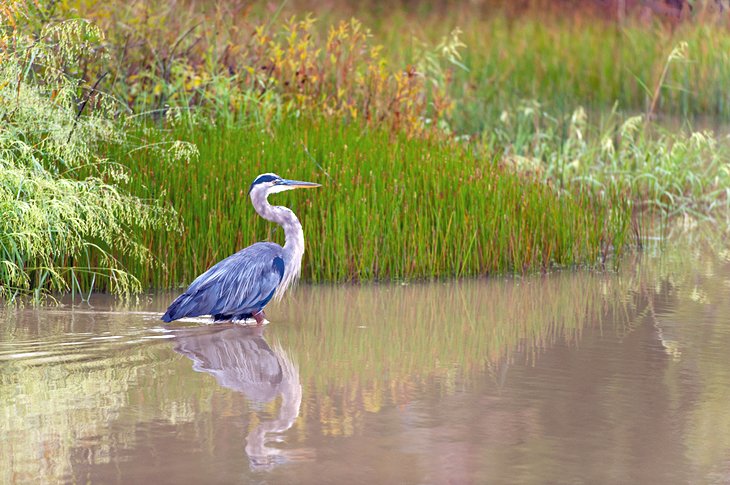
The Blackwater National Wildlife Refuge, 12 miles south of Cambridge on Maryland's Eastern Shore, covers 26,000 acres of marshes, ponds, and forest. The refuge provides habitat for large numbers of migratory birds and is a popular spot with bird-watchers. The area is also home to the rare Delmarva Peninsula fox squirrel, only recently removed from the endangered species list.
The best times to visit are in the spring and fall when birds are moving through, but the property is lovely, and you'll see wildlife at any time of year. A visitor center has information on the wetlands. The best way to see the refuge is on one of the numerous walking trails or from the Wildlife Drive.
Address: 2145 Key Wallace Drive, Cambridge, Maryland


